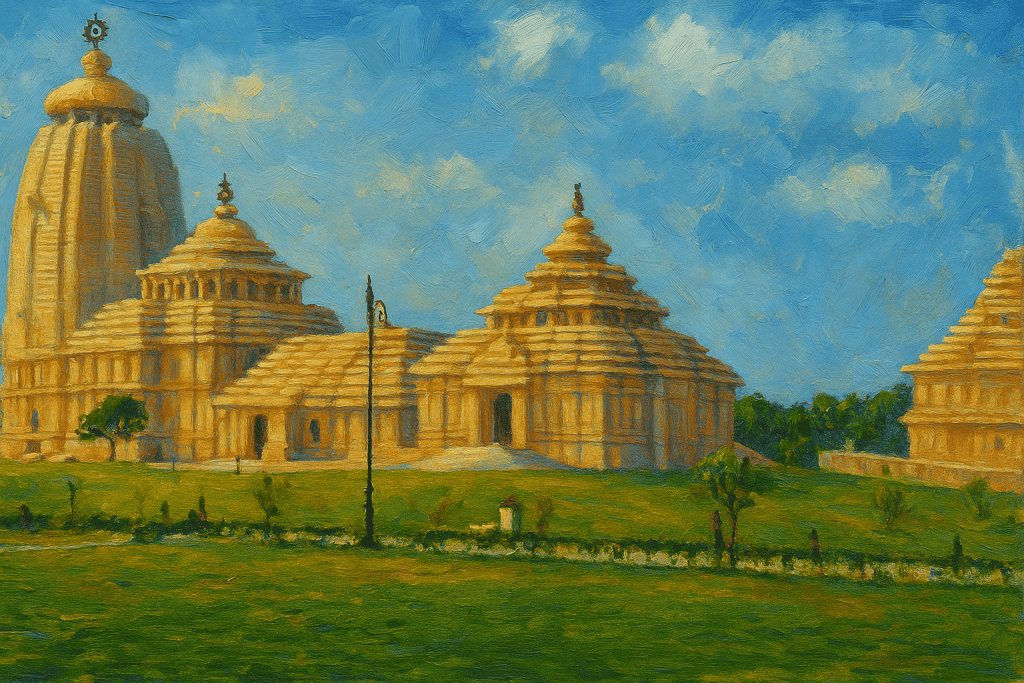Digha’s newly unveiled Jagannath Dham offers divine architecture, coastal vibes, and inclusive spiritual experiences.

The newly inaugurated Digha Jagannath Dham Temple unveiled in April 2025 in the picturesque coastal town of Digha, West Bengal, stands as a distinguished addition to the region’s spiritual heritage. With its remarkable architectural design, inclusive atmosphere, and scenic seaside setting, this temple is rapidly establishing itself as an important destination for devotees, cultural connoisseurs, and travellers seeking both spiritual enrichment and natural beauty. The Digha Jagannath Dham Temple enriches Bengal’s religious landscape with dignity and grace, reflecting a harmonious blend of tradition and contemporary significance.
A Temple Rooted in Legacy and Vision
The temple is a faithful replica of the world-famous Jagannath Temple in Puri, Odisha, built in the elegant Kalinga architectural style. Towering shikharas, intricately carved walls, and vivid murals pay homage to ancient artistry while embracing a modern vision of inclusion.
The construction was led by the West Bengal Housing Infrastructure Development Corporation (WBHIDCO), with artisans from both Bengal and Odisha coming together to bring the sacred vision to life. Unlike the original Puri temple, which restricts non-Hindus and foreigners, the Digha Jagannath Temple is open to all, making it a symbol of cultural openness and communal harmony.
The Digha Jagannath Temple was officially inaugurated on April 30, 2025, by West Bengal Chief Minister Mamata Banerjee in a grand ceremony attended by ministers, dignitaries, and thousands of devotees. Banerjee actively participated in the rituals, setting a precedent for political leaders taking part in religious celebrations.
With an inclusive ethos and a spirit of openness, the Digha Jagannath Temple warmly welcomes people of all faiths and backgrounds, including international visitors. It stands as a modern expression of India’s age-old belief in Vasudhaiva Kutumbakam—the world is one family—inviting all who seek peace and divine connection.
Throughout the year, the temple becomes a vibrant centre for devotional celebrations and community gatherings. The Rath Yatra, in particular, is expected to become a prominent annual festival here, echoing the joy and reverence of the world-renowned Puri Rath Yatra. Even on ordinary days, the temple resonates with the sounds of bhajans, aarti, and spiritual discourse, offering a continuous space for devotion and unity.
The Temple Construction
The temple’s majestic architecture pays homage to the traditional Kalinga style, with towering shikharas that echo the grandeur of classical temples. For visitors, the temple offers not only a place for worship but also a chance to witness the enduring beauty of India’s sacred design traditions. Inspired by the revered 12th-century Jagannath Temple in Puri, Odisha, the Digha temple brings the essence of one of India’s most sacred pilgrimage destinations into a contemporary context. Spread across an impressive 24 acres, the temple complex includes all four principal structures typical of classical Kalinga-style architecture: the Vimana (sanctum), Jagamohan (assembly hall), Nat Mandir (dance hall), and Bhog Mandap (offering hall).
What sets the Digha temple apart is its stunning use of over 300,000 cubic feet of Bansi Paharpur pink sandstone, known for both its beauty and strength. More than 3,000 artisans and workers dedicated three years to shaping this architectural marvel.
Inside the sanctum, the stone idols of Lord Jagannath, Balabhadra, and Subhadra rest on the sacred Ratnabedi, closely following the traditional arrangement seen at Puri. Adding to the temple’s spiritual rhythm is a set of wooden idols carved from neem wood by renowned Bhubaneswar-based sculptor Sudarshan Maharana. These will be paraded during the annual Rath Yatra, offering a ceremonial connection to the moving traditions of Puri. Notably, the wooden deities used here are crafted from ordinary neem wood, not the sacred Daru (divine neem) used in Puri’s Nabakalebara ritual, clarifying earlier media speculation with official confirmation.
Occupying a sprawling 20–24 acre site near Digha railway station, the temple complex is organised into the four classical components of Kalinga temple architecture: the Vimana (sanctum sanctorum), Jagamohan (assembly hall), Nat Mandir (dance hall), and Bhog Mandap (offering hall). The temple rises to a height of 65 metres (213 feet), making it one of the tallest religious structures in the region. Its construction utilised more than 300,000 cubic feet of distinctive pink sandstone from Bansi Paharpur, Rajasthan, chosen for its durability and warm, glowing hue. The flooring throughout the complex is crafted from imported Vietnamese marble, adding both elegance and resilience.
The temple’s entrances are a visual highlight, featuring four grand gateways—Singhadwara (lion gate), Byaghradwara (tiger gate), Hastidwara (elephant gate), and Ashwadwara (horse gate)—each echoing the symbolic motifs of the Puri temple. The main entrance, Chaitanyadwar, leads into the central axis of the temple and sets the tone for the intricate carvings and sculptural details that adorn the entire complex. Over 3,000 workers and more than 800 skilled artisans, many from Rajasthan, contributed to the detailed carvings, symmetry, and grandeur that define the temple’s aesthetic, with construction completed in just under three years.
Inside the sanctum, the temple houses stone idols of Lord Jagannath, Lord Balabhadra, and Goddess Subhadra, enshrined atop the sacred Ratnabedi.. This is a notable departure from the Puri tradition, where the deities are carved from neem wood and replaced periodically through the Nabakalebara ritual. The Digha temple’s idols, carved from stone, reflect both permanence and the temple’s unique identity within the Jagannath tradition.
The temple complex also includes a dedicated shrine for Goddess Lakshmi, a separate Bhogshala (kitchen) for preparing sacred offerings, and extensive theme lawns with over 500 newly planted trees, enhancing its serene and welcoming atmosphere. The design incorporates modern amenities for pilgrims, including rest areas and accessibility features, while maintaining strict adherence to traditional proportions and symbolism.
Distinctive architectural features such as the temple’s 65-metre-high vimana, the four symbolic gates, and the intricate stonework are complemented by spiritual elements like the flag atop the temple (which, as in Puri, is said to fly against the wind) and the Sudarsana Chakra, which creates an optical illusion by appearing the same from every angle The temple’s inclusive access policy, welcoming devotees of all backgrounds, further distinguishes it as a modern spiritual and cultural landmark.
For visitors and pilgrims alike, the Jagannath Dham Temple in Digha is a place where tradition meets renewal. It invites you to pause, offer your prayers, and appreciate how sacred architecture continues to evolve, honouring the past while shaping the present.
Kalinga Style of Temple Architecture
Most distinctive of the features of Kalinga architecture is the clear hierarchical layout of temple complexes, typically comprising several aligned structures: the deul or vimana (sanctuary with the main deity and its soaring tower), the jagamohana, the nata-mandira, and the bhoga-mandapa. This axial alignment not only serves ritual purposes but also reflects a cosmic symbolism, representing the devotee’s spiritual progression from the earthly to the divine.
A hallmark of Kalinga architecture is its classification into three main temple types: Rekha Deula, Pidha Deula, and Khakhara Deula.
Rekha Deula is characterised by a tall, curvilinear spire (shikhara) over a square sanctum, usually housing deities like Vishnu, Shiva, or Surya. The spire arches inward and tapers sharply at the top, often topped with a ribbed disk (amalaka) and a pot-like finial (kalasa).
Pidha Deula features a pyramidal roof made of horizontal, receding tiers, generally used for the jagamohana or the assembly hall. These tiers are grouped in sets separated by recessed mouldings, creating a stepped appearance.
Khakhara Deula stands out with its barrel-vaulted, elongated roof over a rectangular plan, and is typically associated with temples dedicated to goddesses like Chamunda or Durga.
The vertical elevation of a Kalinga temple is divided into three major segments: the pabhaga (base), jangha (walls), and gandi (spire or roof). The exteriors are richly adorned with sculptural decorations—images of deities, dancers, musicians, mythological scenes, and elaborate floral and geometric motifs—demonstrating the region’s artistic mastery. The walls are further divided into projections and recesses called paga or ratha, with the central one (raha-paga) and corner ones (kanika-paga) being especially prominent. As temple design evolved, the number of these projections increased, resulting in more complex and visually dynamic structures.
Entrances to the sanctum or halls often feature ornate lintels with depictions of the navagraha (nine planetary deities), and lion masks (kirti-mukha) are common decorative motifs above doorways. The use of durable materials like sandstone, soapstone, and laterite, along with advanced stone-carving techniques, allowed for both longevity and exquisite detail. The temple shikhara is capped with a mastaka, a multi-part finial symbolising the cosmic axis, and the Sudarsana Chakra or flag atop the temple often serves as a spiritual beacon.
Kalinga temples were not only centres of worship but also hubs for social and cultural gatherings, with the nata-mandira hosting ritual dances and the bhoga-mandapa serving communal meals. The style’s grandeur, symbolism, and technical sophistication make it a defining chapter in Indian temple architecture, with masterpieces like the Jagannath Temple in Puri, Lingaraj Temple in Bhubaneswar, and Konark Sun Temple standing as enduring legacies.
Rath Yatra 2025
On June 27, 2025, Digha hosted its first-ever Rath Yatra, echoing the grandeur of Puri’s famous chariot festival. The atmosphere was electric as Chief Minister Mamata Banerjee ceremonially swept the chariot path with a golden broom at 1:45 pm; symbolising humility and divine service. The deities Lord Jagannath, Lord Balabhadra, and Devi Subhadra were then placed on their ornate chariots for a 1 km procession, starting at 2:30 pm and concluding by 4 pm.
To ensure safety, barricades lined the entire route, and instead of crowding the streets, devotees symbolically pulled ropes that extended to their sides of the barriers. The entire stretch was brought to life with giant deity cut-outs, Chandernagore-style illuminations, devotional music, and a palpable sense of unity and celebration.
The festival attracted lakhs of devotees, including international participants from over 50 countries, a unique facet not seen in Puri. ISKCON devotees contributed vegetarian offerings for the bhog, and their global presence highlighted Digha’s growing reputation as a spiritual site with universal appeal.
Where Is It Located?
The temple is located in New Digha, a bustling part of the famed beach town in Purba Medinipur district, West Bengal. Positioned just a short walk away from the Bay of Bengal, the temple blends spiritual calm with Digha’s festive coastal vibe. With golden sands, rolling waves, and the call of temple bells, this is where sacred meets scenic.
How to Reach:
- By Train: Digha is well-connected by train to major cities in West Bengal. The nearest railway station is Digha Flag Station (DGHA), just 2 km from the temple. Trains run daily from Howrah and Santragachi stations in Kolkata, making it a smooth journey for weekenders and pilgrims alike.
- By Road: From Kolkata, the drive to Digha is about 185 km and takes around 4–5 hours via NH16 and NH116B. Buses to Digha leave regularly from Esplanade Bus Terminal, and the scenic coastal route is part of the charm.
- By Air: The nearest airport is Netaji Subhas Chandra Bose International Airport in Kolkata. From there, you can take a taxi or a bus to Digha, or combine rail and road travel.
Tips for Visitors
- Best Time to Visit: October to March offers pleasant weather. Rath Yatra in June is spiritually significant, but expect large crowds.
- What to Wear: Modest clothing is recommended, especially during religious events.
- Where to Stay: Digha has a wide range of accommodation options from budget hotels to luxury beach resorts, all within walking or short driving distance from the temple.
- What to Eat: Feast on fresh seafood, Bengali sweets like rosogolla and sandesh, and local snacks like ghugni and coconut water near the beach.
Read More: Latest



